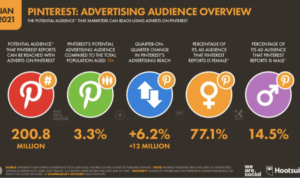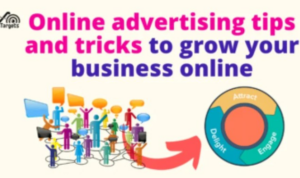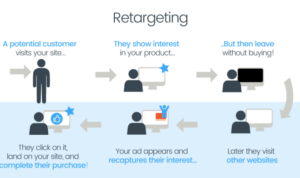Email Marketing Tips: Get ready to supercharge your marketing game with these cutting-edge strategies that will take your campaigns to the next level. From building a killer email list to crafting compelling content, this guide has got you covered.
Importance of Email Marketing
Email marketing is a crucial tool for businesses looking to reach their target audience effectively. With the ability to personalize messages, segment subscribers, and track performance, email marketing has become a staple in digital marketing strategies.
Effectiveness of Email Marketing
According to HubSpot, email marketing has an average ROI of 3800%, making it one of the most cost-effective marketing channels available. Additionally, 80% of professionals believe that email marketing increases customer retention and acquisition.
Success Stories of Companies
- Amazon: Amazon uses personalized product recommendations in their emails, resulting in a 29% increase in sales.
- Uber: Uber sends targeted emails to users based on their location and behavior, leading to a 20% increase in engagement.
- Airbnb: Airbnb uses email marketing to showcase unique listings and experiences, driving a 10% increase in bookings.
Building an Email List
Building an email list is crucial for the success of your email marketing campaigns. It involves collecting email addresses of potential customers who have shown interest in your products or services. Here are some strategies to help you grow your email list organically:
Importance of Segmentation in Email Lists
Segmentation is key to effective email marketing. By dividing your email list into smaller, targeted groups based on specific criteria such as demographics, behavior, or interests, you can send more personalized and relevant content to your subscribers. This leads to higher open rates, click-through rates, and ultimately, conversions.
- Segment your email list based on customer preferences and behavior to send tailored content.
- Use segmentation to send targeted promotions and offers to specific groups of subscribers.
- Personalize email campaigns based on segmentation to increase engagement and drive conversions.
Segmentation allows you to deliver the right message to the right audience at the right time, maximizing the effectiveness of your email marketing efforts.
Tips on Creating Lead Magnets to Attract Subscribers
Lead magnets are valuable incentives that you offer to your website visitors in exchange for their email addresses. They can help attract new subscribers to your email list. Here are some tips for creating compelling lead magnets:
- Create high-quality content that provides value to your target audience, such as eBooks, guides, or templates.
- Offer exclusive discounts, promotions, or free trials to encourage visitors to subscribe to your email list.
- Use interactive tools like quizzes or assessments to engage visitors and capture their email addresses.
Remember, the key to a successful lead magnet is to offer something of value that addresses the needs or interests of your target audience.
Crafting Compelling Email Content
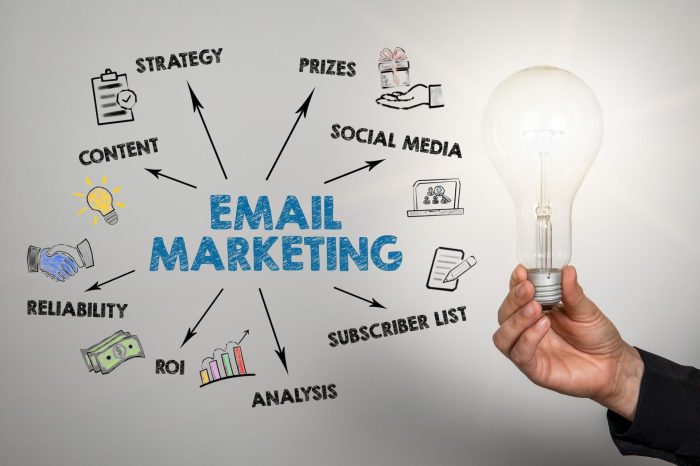
Crafting compelling email content is essential for engaging your audience and driving conversions. A well-crafted marketing email should include the following elements:
Elements of a Well-Crafted Marketing Email, Email Marketing Tips
- Clear and concise messaging
- Engaging visuals or multimedia elements
- Personalization to address the recipient by name
- Call-to-action (CTA) that prompts the recipient to take action
- Mobile responsiveness for easy viewing on all devices
Tips for Writing Engaging Subject Lines
- Keep it short and sweet – aim for 50 characters or less
- Use action-oriented language to encourage opens
- Personalize the subject line with the recipient’s name or location
- Create a sense of urgency or exclusivity
- A/B test different subject lines to see what resonates best with your audience
Examples of Successful Email Content
“Exclusive 24-Hour Sale – Get 50% Off Today Only!”
This subject line creates a sense of urgency and offers a compelling discount, driving opens and conversions.
“Your Personalized Style Guide is Here!”
By personalizing the email content, this message appeals to the recipient’s individual preferences and increases engagement.
“Don’t Miss Out – Limited Edition Collection Now Available”
This subject line creates a fear of missing out (FOMO) and entices recipients to explore the new collection.
Email Automation
Email automation is a powerful tool in marketing campaigns that can help businesses save time, increase efficiency, and drive engagement with customers. By setting up automated email sequences, businesses can deliver personalized messages at the right time, nurturing leads and converting them into loyal customers.
The Benefits of Email Automation
- Increased efficiency: Automating repetitive tasks like sending welcome emails or follow-ups frees up time for marketers to focus on strategy and creativity.
- Personalization: Automated emails can be tailored to specific customer segments based on their behavior, preferences, and interactions with your brand.
- Improved engagement: By sending relevant content at the right time, automated emails can help nurture leads and guide them through the customer journey.
- Consistency: Automation ensures that every subscriber receives the same level of communication, maintaining brand consistency and messaging.
Setting Up Automated Email Sequences
To set up automated email sequences, businesses can use email marketing platforms like Mailchimp, Constant Contact, or HubSpot. Here’s a basic Artikel of how to do it:
- Define your goals: Determine the objectives of your email automation campaign, whether it’s lead nurturing, onboarding, or re-engagement.
- Create a workflow: Map out the customer journey and identify key touchpoints where automated emails can be triggered.
- Segment your audience: Divide your email list into different segments based on demographics, behavior, or interests to send targeted messages.
- Set up triggers: Define the actions or events that will trigger automated emails, such as signing up for a newsletter or abandoning a shopping cart.
- Create compelling content: Craft engaging and relevant email content that resonates with your audience and drives them to take action.
- Monitor and optimize: Track the performance of your automated email sequences, analyze the data, and make adjustments to improve results over time.
Examples of Successful Automated Email Campaigns
Some examples of successful automated email campaigns include:
- Abandoned cart emails: Remind customers about items they left in their shopping cart and encourage them to complete the purchase.
- Onboarding sequences: Welcome new subscribers or customers with a series of emails that introduce them to your brand, products, or services.
- Re-engagement campaigns: Reach out to inactive subscribers with targeted offers or content to rekindle their interest and bring them back into the fold.
A/B Testing in Email Marketing: Email Marketing Tips
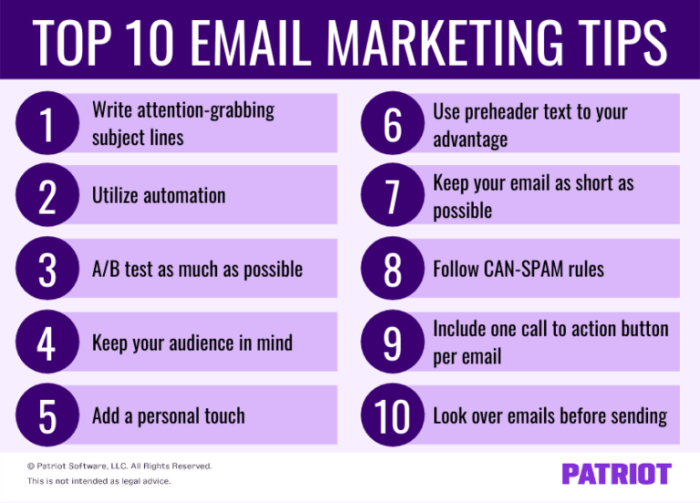
A/B testing in email marketing is a crucial technique used to compare two versions of a marketing campaign to determine which one performs better. By sending out two variations of an email to different segments of your audience, you can analyze the results and make data-driven decisions to optimize your email campaigns.
Elements to Test in Email Campaigns
- Subject Lines: Test different subject lines to see which one generates higher open rates.
- Call-to-Action: Experiment with different CTAs to determine which one drives more clicks and conversions.
- Email Content: Test variations in the email body, images, and layout to see what resonates best with your audience.
- Sending Time: Test different send times to find out when your audience is most engaged.
Interpreting and Acting on A/B Test Results
- Statistical Significance: Ensure that your test results have reached statistical significance before making any conclusions.
- Implement Changes: Once you have identified the winning variation, implement the changes in your future email campaigns.
- Continuous Testing: A/B testing should be an ongoing process to constantly optimize your email marketing strategy.
- Learn from Failures: Even if a test fails, analyze the results to understand why and apply those learnings to future tests.

